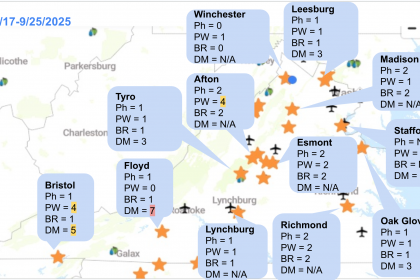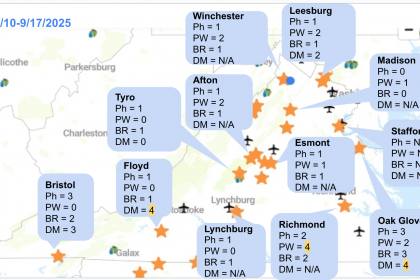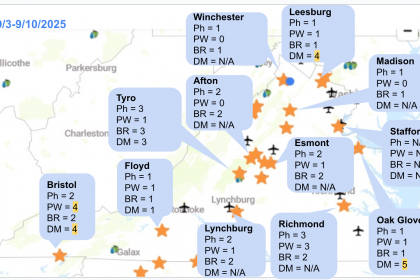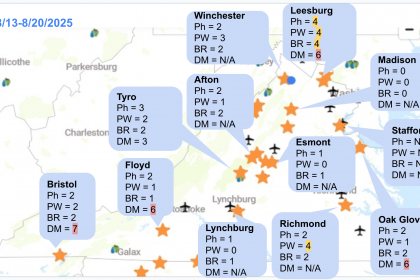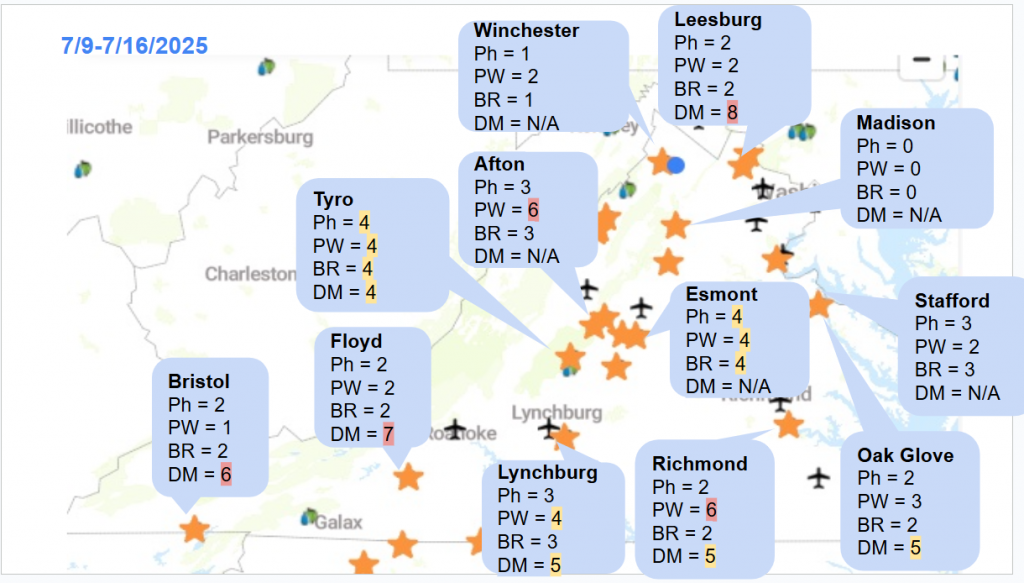
Grape disease risks from the NEWA
Here are snapshots from the last week, showing the number of days with the risk of each disease: Ph = Phomopsis, PW = Powdery mildew, BR = Black rot, and DM = Downy mildew. N/A means there is no data or some issues with the NEWA (I reported to the NEWA.)
Downy mildew risk forecast
In addition, we generated downy mildew forecasted risk based on the past seven days of weather and an 8-day forecast. Please click the figure below to enlarge. The rains from last week and forecasted rain events pose high-risk events for several locations across Virginia. This effort has been supported by the VA Wine Board and Southern Region Small Fruit Consortium.

A quick note on fungicide resistance
Fungicide resistance is a serious and tangible problem. Fungal pathogens can develop resistance through different mechanisms. Usually, long-term use of a specific mode of action leads to the selection of resistant fungal populations. While some resistant populations may not survive long due to associated costs, many do thrive. Once resistance appears in your vineyard, it often persists for a long time.
The mode of action is conveniently summarized as FRAC groups (Fungicide Resistance Action Committee, FRAC | Home), which are listed on fungicide labels and in this guide. It’s important to recognize that different chemicals can share the same mode of action, and some products combine two modes of action. Rotating the mode of action (FRAC group) is essential, as different products or chemicals may belong to the same FRAC group. For example, rotating Rally (myclobutanil) with Elite (tebuconazole) is not a rotation since both are in FRAC group 3. The same applies to Flint and Pristine, both containing FRAC group 11. If the FRAC group does not have the designation “M,” it probably indicates a single mode of action. When using products with the FRAC group starting with a number or letter “U,” it’s crucial to rotate them, limit their use (preferably to twice per year), and tank-mix them with products in FRAC groups beginning with the letter “M,” such as sulfur, copper, mancozeb, ziram, and captan, to reduce the risk of fungicide resistance.
Instances of resistance to certain FRAC groups have been found in Virginia.
Powdery mildew:
- benzimidazoles (FRAC = 1) and QoIs (FRAC = 11) are no longer effective.
- DMI (FRAC = 3) still works but may show reduced efficacy depending on the product.
- Quintec (FRAC = 13) resistant strains of powdery mildew have been reported in VA (= not widespread).
Downy mildew:
- Revus (FRAC = 40) resistance has been reported in several VA vineyards.
- QoIs (FRAC = 11) are no longer effective.
- Phosphites (also called Phos acid, FRAC = P07): Increasing cases of resistant isolates are being seen in VA.
Botrytis gray mold:
- bimidazoles (FRAC = 1) and QoIs (FRAC = 11) are no longer effective.
- Reduced sensitivity has been observed with iprodione (FRAC = 2), Vanguard (FRAC = 17), and SDHI (FRAC = 7, e.g., Luna, Kenja, Merivon, etc.).
Ripe rot:
- Several QoI (FRAC = 11) resistant isolates have been reported in VA.
- Overall, SDHI (FRAC = 7) fungicides are generally not effective, except for Aprovia.
In some cases, efficacy depends on the product, meaning significant differences may be observed among products; however, if they are in the same FRAC group, the risk of resistance development remains similar. Therefore, rotation and mixing are vital for effectively managing fungal diseases.
If you have any suspicious cases of fungicide resistance, please do not hesitate to contact me.
